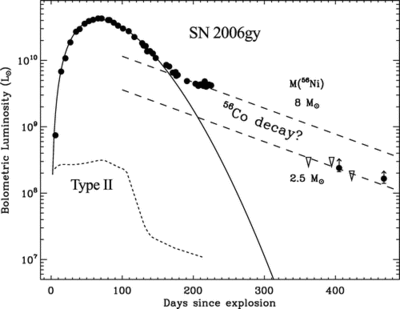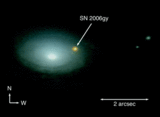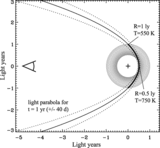Image Details

Caption: Fig. 2.
Bolometric luminosity light curve of SN 2006gy. The data points up to day 230 are from the absolute R magnitudes in Paper I, with no bolometric correction. The solid curve is the "shell‐shocked" photon diffusion model of Smith & McCray (2007). The two late‐time data points are lower limits to the luminosity derived from our observed ﹩K^{\prime }﹩‐band magnitudes, assuming that the SED peaks in the ﹩K^{\prime }﹩ band. Dashed lines show the expected energy deposition rate for representative masses of 56Ni, assuming 100% efficiency of the ejecta in absorbing radioactive decay luminosity (this may be optimistic, and so the 56Ni mass indicated by the observed luminosity may be higher). Since the late‐time IR luminosities are lower limits, we emphasize that 2.5 M⊙ is only a lower bound for the 56Ni mass in the radioactive decay hypothesis. Similarly, while open triangles denote KAIT and Keck/LRIS R‐band upper limits, they are not really limits to the bolometric luminosity, because the SED does not peak in the R band.
Copyright and Terms & Conditions
© 2008. The American Astronomical Society. All rights reserved. Printed in U.S.A.






